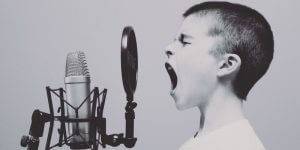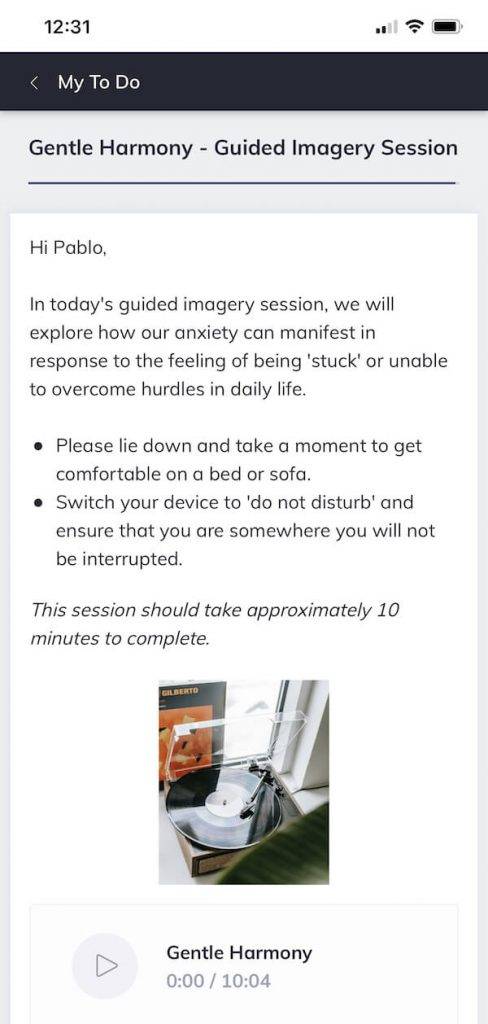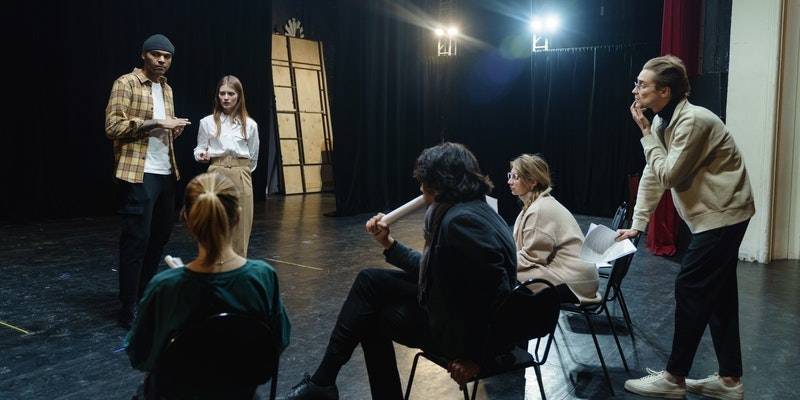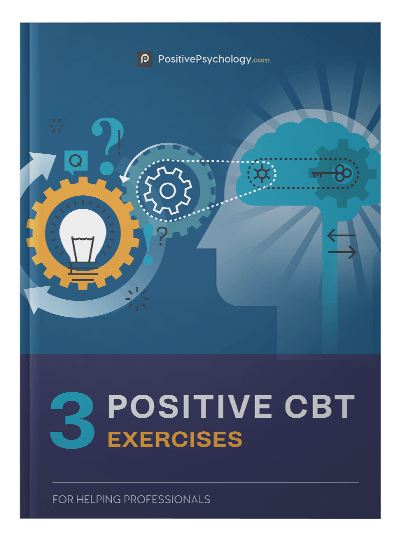What are the Benefits of Music Therapy?
 Since the earliest days of humankind, music and the power of music, has been evident to us.
Since the earliest days of humankind, music and the power of music, has been evident to us.
After World War II, a new profession entered the arena – music therapy. With far-reaching benefits and in a variety of settings, the types and methods of music therapy have had a profound impact.
Used in conjunction with traditional therapies, positive psychology, and even as a stand-alone intervention, music therapy offers a variety of benefits. It is these benefits we will evaluate here.
Before you read on, we thought you might like to download our 3 Positive Psychology Exercises for free. These science-based exercises will explore fundamental aspects of positive psychology including strengths, values and self-compassion and will give you the tools to enhance the wellbeing of your clients, students or employees.
This Article Contains:
- 6 Proven Benefits of Music Therapy
- What are the goals and objectives of music therapy?
- What Effects Can Music Therapy Have on a Client?
- What Can Music Therapy be Used For?
- 9 Interesting Facts and Statistics
- A Look at the Nordoff-Robbins Approach
- Relaxation and Music Therapy
- 4 Music Therapy Ideas and Interventions
- 12 Recommended Songs Commonly Used
- 10 Music Therapy Activities and Exercises for Adults
- 5 Group Ideas and Activities
- Technologies to Support Music Therapy Interventions
- Using Music Therapy in Schools
- Music Therapy for Children
- 5 Ideas for Kids
- A Take-Home Message
- References
6 Proven Benefits of Music Therapy
Jillian Levy (2017) shares the six major health benefits of music therapy:
- Music therapy reduces anxiety and physical effects of stress
- It improves healing
- It can help manage Parkinson’s and Alzheimer’s disease
- Music therapy reduces depression and other symptoms in the elderly
- It helps to reduce symptoms of psychological disorders including schizophrenia
- Music therapy improves self-expression and communication
What are the Goals and Objectives of Music Therapy?

This may include, for example, improving motor function, social skills, emotions, coordination, self-expression and personal growth (Therapedia, n.d.).
Common goals in music therapy, as identified by Everyday Harmony (n.d.) are the development of:
- Communication skills (using vocal/verbal sounds and gestures)
- Social skills (making eye contact, turn-taking, initiating interaction, and self-esteem)
- Sensory skills (through touch, listening, and levels of awareness)
- Physical skills (fine and gross motor control and movement)
- Cognitive skills (concentration and attention, imitation, and sequencing)
- Emotional skills (expression of feelings non-verbally)
What Effects Can Music Therapy Have on a Client?
Music can affect a client’s attention, emotion, cognition, behavior, and communication (Koelsch et al., 2009). It can also help bring about relaxation and pleasure (Koelsch et al., 2009). Music also affects perception (Koelsch et al., 2009). Training in music promotes an individual’s skills in the decoding of acoustic features, such as pitch height and frequency modulation (Koelsch et al., 2009).
Music has various effects on the activity of a large range of brain structures (Koelsch et al., 2009). Functional neuroimaging studies have shown that listening to music can have effects on the core structures of emotional processing (the limbic and paralimbic structures) in both musicians and ‘non-musicians’ (Koelsch et al., 2009).
The peripheral physiological effects of listening to music and making music are still being looked into (Koelsch et al., 2009). However, given the effects of emotion on the autonomic nervous system, endocrine system, and immune system – and the fact that music has the power to evoke and modulate emotions – Koelsch and colleagues (2009) suggest that music therapy may be used to treat disorders associated with dysfunctions and imbalances within these systems.
What Can Music Therapy be Used For?

Music therapy can be used for facilitating movement and overall physical rehabilitation and motivating clients to cope with treatment. It can provide emotional support for clients and their families, and provide an outlet for expression of feelings.
Credentialed music therapists can work with patients with an acquired brain injury (AMI). For example, music therapy helped congresswoman Gabby Giffords to regain her speech after she survived a bullet wound to her brain. Music therapy can be used to lessen the effects of dementia, reduce asthma episodes in both children and adults and help reduce pain in hospitalized patients.
Music therapy can also be used to help children with autism spectrum disorder to improve their communication capabilities. Furthermore, it can help premature infants improve sleep patterns and increase their weight gain. Finally, music therapy can be used to help individuals with Parkinson’s disease to improve motor function.
9 Interesting Facts and Statistics
- 86% of users of the Nordoff-Robbins music therapy services said that music therapy had enabled them to develop social skills and interaction (Nordoff Robbins, n.d.)
- Your heartbeat changes to mimic the music that you listen to
- Distinguishing changes in sounds were found to be equipped in those as small as a developing fetus
- Listening to happy vs. sad music can affect the way you perceive the world around you
- An “earworm” is a song that you can’t seem to get out of your head
- A ‘brain itch’ is a need for the brain to fill in the gaps in a song’s rhythm
- Music triggers activity in the same part of the brain that releases dopamine (the ‘pleasure chemical’)
- Music triggers networks of neurons into an organized movement
- Learning a musical instrument can improve fine motor and reasoning skills
These interesting facts were sourced from Ashley Blodgett (2015).
A Look at the Nordoff-Robbins Approach
The following information was found on the Nordoff Robbins website.
In the 1950s, 1960s, and 1970s, the Nordoff-Robbins approach was developed by Paul Nordoff (an American composer and pianist) and Clive Robbins (a teacher of children with special needs from Britain). This is not a ‘method’. It is an approach designed to harness every person’s potential for engagement in active, communicative, expressive music-making.
The Nordoff-Robbins approach began as a form of collaborative music-making used to engage vulnerable and isolated children. Nordoff and Robbins term this ‘therapy in music’.
The Nordoff-Robbins approach emphasizes the importance of music-making in developing skills, a sense of self and a capacity for satisfying social interaction. It recognizes that all people, regardless of pathology, illness, disability, trauma or social isolation have the potential to make music.
The approach is well known for its work with children and adults with learning difficulties. This is because, like all forms of music therapy, the work has a non-verbal basis.
Every music therapist using the Nordoff-Robbins approach thinks strategically. Using their musical abilities, they help people in ways that are specific to each person, each group, or each community.
Relaxation and Music Therapy
While most of us would agree that music can be relaxing, how is relaxation promoted with music therapy? To begin with, music can lead to relaxation of tense muscles. When you allow your muscles to relax and loosen your body, your mind relaxes too. Music is fun, cheap, and simple. It can decrease all the tension, worries and stress you may not even have been aware of (Scott, 2018).
Listening to music can also enhance other stress-relieving activities. For example, it can aid in practicing yoga, self-hypnosis or guided imagery. In other words, music can enhance the stress-relieving properties of other relaxing activities (Scott, 2018).
Music can also help the brain reach a meditative state. This promotes relaxation. Listening to music may be a less intimidating way for a client to practice meditation (Scott, 2018).
4 Music Therapy Ideas and Interventions

1. Singalong
Fandom (n.d.) suggest that music therapy sessions for groups or individuals may include singing together in a way less formal than a choir.
The singalong may use a songbook of the music therapist’s repertoire, or plain copies of popular song lyrics (Fandom, n.d.). Participants could sing preferred and highly familiar songs by memory, or learn a new song by rote (Fandom, n.d.).
Singalongs encourage participation in a fun, music-making process (Fandom, n.d.). They can be used to meet various goals and objectives, including teaching breathing exercises (Fandom, n.d.).
2. ‘Blackout song-writing’ (Seibert, n.d.).
In this session, the therapist provides clients with the lyrics to 4 – 5 different choices of songs which represent recovery – such as overcoming barriers, support, or struggles. Then, clients are encouraged to take some time to read the lyrics of the song they choose, and to select words from the lyrics to make up their own song.
The idea is to ‘blackout’ the lyrics which the client does not want in the song and to use the words that they have chosen to create their own song.
3. Musical Hangman (Seibert, n.d.).
This idea is to draw a thematic picture on a board, and ask clients to guess the missing word before the picture loses its details – e.g. to try and guess the word before the tree loses all its’ leaves.
Then, choose a thematic word and find songs that start with each letter of that word. The aim is for clients to listen to the songs and try and guess the target word. For example, the word ‘happy’ may have the songs “Hey Jude”, “A Little Ray of Sunshine”, “Praying” and so on.
Each letter that is guessed correctly earns the corresponding song to play and sing. The therapist can even coordinate songs that share a thematic idea as well as matching the letter.
4. Blues Song-writing (Seibert, n.d.).
The music therapist explains the background of the blues, so that the client understands the basics – i.e. having a line A, repeating line A and a subsequent line B. Ask the client to share something that they may be feeling ‘blue’ about, and to think of a solution to the problem or a coping mechanism. Then, brainstorm ideas as to how to make the statements sound poetic in song-writing.
After each client has had a chance to write their ‘blues’, have a continuous improvisation/singalong. Sing each person’s ‘blues’ as a group, following the same melody line. This activity can be extended using an iPad: clients can improvise on the blues scale keyboard on the app ‘GarageBand’.
12 Recommended Songs Commonly Used
According to Rachel Rambach (2011), the following are twelve songs that every music therapist should know:
- ‘American Pie’
- ‘Amazing Grace’
- ‘Blue Suede Shoes’
- ‘Blue Skies’
- ‘Don’t Worry, Be Happy’
- ‘The Lion Sleeps Tonight’
- ‘Lean on me’
- ‘Ob-la-di’
- ‘Somewhere Over the Rainbow’
- ‘Take Me to The Ballgame’
- ‘This Little Light of Mine’
- ‘You Are My Sunshine’
10 Music Therapy Activities and Exercises for Adults
The following are research-based music therapy activities (interventions) for adults, found in Wigram and colleagues’ 2002 book.
- Improvisation
- Singing well-known songs
- Vibroacoustic therapy
This is a receptive form of music therapy. It involves music being played through speakers which are built into a chair, mattress or bed (which the client lies in). Then, the client directly experiences the vibrations that are brought about by the music (Wigram, Pedersen & Bonde, 2002). - Stress-reduction techniques
- Music and movement
- Folk dancing or social dancing
- Vibrotactile stimulation
- Music reminiscence
- Music stimulation
- Songwriting
For more information about any of these activities, Wigram et al. (2002) provide the scientific references associated with each activity on pages 193 – 194.
5 Group Ideas and Activities
Music therapy in groups are well-known, and the following activities can help you with your next group session.
1. ‘Beach ball autonomy’ (Seibert, n.d.)
Use a blow-up beach ball and draw on a range of shapes. Inside each, write genres, styles and generic artists. Toss the ball to a client. Whichever shape their thumb lands on describes the next song selection.
The therapist encourages the client to choose a selection of appropriate songs so that the therapist can choose the preferred song for that individual. The client also gets to choose whether the group will play instruments, sing, dance, or just listen.
2. Drumming Emotions (Fandom, n.d.).
Each member of the group writes down one word to describe the emotion that they are feeling on a slip of paper. The paper is then put in a hat/bowl and group members take turns in selecting a different piece of paper. The person will then ‘perform’ (demonstrate) on the drum the emotion that is written on the paper. The rest of the group listens and tries to identify who in the group the emotion belongs to.
3. Conversation Drum Circle (Fandom, n.d.).
The group plays a beat, and in pairs take turns in a ‘musical dialogue’ exchange.
4. Name-That-Tune! (Fandom, n.d.).
The music therapist asks clients to form two or three teams and to come up with a team name. Play appropriate music and each team has a turn at earning points for stating the name of the song, the group or artist, or sharing interesting, relevant facts about the song.
It can also be fun to open up the guessing to the whole group if they are unable to identify the song. You could play “free-for-all” lightning rounds or use TV show themes, or popular movie soundtracks.
5. Music trivia (Fandom, n.d.).
This game challenges teams to answer trivia questions on music and pop-culture.
Technologies to Support Music Therapy Interventions

Some interventions invite active engagement, such as through dancing or playing instruments, while others require patients simply to listen to music.
Sometimes, music therapists prescribing passive interventions may choose to invite their clients to take part in these interventions outside of scheduled therapy sessions.
Many will do so with the support of technologies that allow them to design and distribute customized interventions digitally.
For example, besides in-person interventions, such as drumming or sing-alongs, a music therapist might invite their client to listen to guided imagery recordings containing music.
Using a digital psychotherapy platform such as Quenza (pictured here), these pre-recorded audio clips can be sent directly to the client’s smartphone or tablet according to a predetermined schedule.
Likewise, therapists can use platforms such as this to design and administer reflections or exercises that invite clients to explore their emotional reactions or cognitive responses to different music therapy interventions, thereby supplementing the in-person therapy experience.
This is just a couple of examples of how music therapists might adapt the functions of a blended care platform like Quenza to design holistic treatment solutions for their clients. If you’d like to learn more about designing different therapy interventions using Quenza, take a look at our dedicated psychoeducation interventions article.
Using Music Therapy in Schools
Music therapy can be used with school-aged students in their school setting. Music therapy can be used at school to focus on higher level social and academic skills, including empathy, turn taking, compromise and problem-solving skills in social situations (Jacobson & Artman, 2013).
It can be used to promote academic understanding in mathematics, such as teaching math facts, telling the time, and money concepts. Music therapy can also target academic improvement in reading and writing. For example, music therapy improves phonic and sight words, and story elements (Jacobson & Artman, 2013).
In schools, music therapy can be used to improve children’s behavior and wellbeing. It can help children learn classroom rules, improving attention and focus, and promoting self-expression (Jacobson & Artman, 2013).
Finally, music therapy can be used in schools to improve social skills and communication. For example, it can help with “wh” questions (who, what, where, and when) and develop vocabulary (Jacobson & Artman, 2013).
Music therapy can also be used in Special Education settings. For example, a music therapist may work with a special needs student in the consideration of an Individual Education Program (IEP). They may work with the IEP team and the student’s family throughout the music therapy process (Jacobson & Artman, 2013).
Music Therapy for Children

Music therapy can be a useful way to meet the various psychosocial needs of children, through engagement in song-writing and improvisation. It can provide children with opportunities for self-expression and communication. Music therapy can also give children the opportunity to identify their strengths, providing a way for them to maintain a sense of self-esteem.
For infants and children, a music therapist can use live, familiar music in conjunction with physical, social and cognitive activities to stimulate development. This also promotes interaction and encourages participation and motivation in young children. In order to reduce irritability, pain or anxiety, the music therapist can use soothing music. This also encourages child and family bonding.
To help develop creative self-expression in infants and young children, the music therapist and child can make music together and write songs.
Adolescents can play a more active role in coming up with their own music therapy program. With a therapist, adolescents can explore a range of musical activities and select what feels right to them.
Possible activities for adolescents are song-writing, improvisation and/or singing the songs by their favorite artists or bands. Adolescents may like to use technology to produce personalized audio/visual projects. The use of live music in addition to relaxation techniques can be an effective way to help reduce pain and anxiety in adolescents.
Clinical music therapy may benefit children who are chronically ill (or are long-term hospital patients) or have a developmental delay. It can help children who have autism or are isolated or bed-bound. Music therapy can be used for children who are anxious or depressed, are physically impaired or are frequently admitted to the hospital. Finally, clinical music therapy may benefit children who have experienced trauma.
5 Ideas for Kids
Music Therapy and kids. Peanut butter and jelly. Try out these wonderful ideas.
1. Leader of the band (Fandom, n.d.).
The therapist can sing a little song about who’s turn it is to be the ‘leader of the band’. Demonstrate to the group appropriate directions (such as “start”, “stop”, “LOUD”, “fast”, “slooooow”) or anything that the group will understand.
You may choose a child who is cooperating and listening to directions to be the leader. Children are highly reinforced for their behavior when they get to have a turn in communicating their preferred directions to the whole group.
2. “The Hello Song” from Dragon Tales (Fandom, n.d.).
This song, based on simple chords, is a suitable ‘hello’ song for children under 8 years of age. It brings together social skills, interactive responses and allows an opportunity to greet each child individually. This activity also incorporates vocal and musical opposites such as “high” and “low” and “fast” and “slow”.
3. “Hot Potato” (Fandom, n.d.).
The group passes an object around in a circle, and when the music stops the person holding the object can – answer a question; ask a question; say something about themselves, or discuss something related to treatment.
4. ‘Music bingo’ (Fandom, n.d.)
Create bingo sheets for children that use songs instead of letters and numbers.
5. ‘Pictionary’ (Fandom, n.d.).
Prepare cue cards with song titles written on them for individuals to draw pictures of while their team attempts to guess the song.
A Take-Home Message
We all can attest to the power of music, and using it to teach, calm, and encourage recovery, make it a viable therapy to consider.
We hope this article has given you an indication of some of the benefits of music therapy, and look forward to your feedback and examples where music therapy has benefited your clients.
Continue Reading: 17 Best Drama Therapy Techniques, Activities & Exercises
We hope you enjoyed reading this article. Don’t forget to download our 3 Positive Psychology Exercises for free.
- Blodgett, Ashley (2015). These 12 facts about music, and how they affect your brain, will astound you! Retrieved from https://www.unbelievable-facts.com/2015/04/facts-about-music.html/2
- Blood, A., & Zatorre, R. J. (2001). Intensely pleasurable responses to music correlate with activity in brain regions implicated in reward and emotion. National Academy of Sciences, 98, 11818 – 11823.
- Bradt, J., & Dileo, C. (2010). Music therapy for end-of-life care. Cochrane Database of Systematic Reviews, 1, Art. No: CD007169.
- Children’s Health Queensland Hospital and Health Service (n.d.). Music Therapy. Retrieved from https://www.childrens.health.qld.gov.au/fact-sheet-music-therapy/
- Everyday Harmony (n.d.). What is Music Therapy? Retrieved from www.everydayharmony.org/what-is-music-therapy/
- Fandom (n.d.). Music therapy activities wiki. Retrieved from https://musictherapyactivities.fandom.com/wiki/Music_Therapy_Activities_Wiki
- Forsblom, A., Lantinen, S., Särkämö, T., & Tervaniemi, M. (2009). Therapeutic role of music listening in stroke rehabilitation. The Neurosciences and Music III-Disorders & Plasticity: Annals of the New York Academy of Science, 1169, 426 – 430.
- Gerdner, L. A., & Swanson, E. A. (1993). Effects of individualized music on confused and agitated elderly patients. Archives of Psychiatric Nursing, 7, 284 – 291.
- Geretsegger, M., Elefant, C., Mössler, K. A., & Gold, C. (2014). Music therapy for people with autism spectrum disorder. Cochrane Review of Systematic Reviews, 6, Art. No: CD004381.
- Gold, C., Voracek, M., & Wigram, T. (2004). Effects of music therapy for children and adolescents with psychopathology: A meta-analysis. Journal of Child Psychology and Psychiatry, 45, 1054 – 1063.
- Greenberg, D. M. (2017). The World’s First Music Therapist. Retrieved from https://www.psychologytoday.com/au/blog/the-power-music/201704/the-world-s-first-music-therapist
- Guetin, S., Portet, F., Picot, M. C., Pommie, C., Messgoudi, M., Djabelkir, L. et al. (2009). Effect of music therapy on anxiety and depression in patients with Alzheimer’s type dementia: Randomised, controlled study. Dementia & Geriatric Cognitive Disorders, 28, 36 – 46.
- Hillecke, T., Nickel, A., & Volker Bolay, H. (2005). Scientific perspectives on music therapy. Annals of the New York Academy of Sciences, 1060, 1 – 12.
- Jacobson, V., & Artman, J. (2013). Music therapy in a school setting. Retrieved from https://williams-syndrome.org/sites/williams-syndrome.org/files/MusicTherapyTearSheet2013.pdf
- Klassen, J. A., Liang, Y., Tjosvold, L., Klassen, T. P., & Hartling, L. (2008). Music for pain and anxiety in children undergoing medical procedures: A systematic review of randomized controlled trials. Ambulatory Pediatrics, 8, 117 – 128.
- Koelsch, S. (2009). A Neuroscientific perspective on music therapy. Annals of the New York Academy of Science, 1169, 374 – 384.
- Levy, Jillian (2017). Music therapy: Benefits and uses for anxiety, depression and more. Retrieved from https://draxe.com/music-therapy-benefits
- Maratos, A., Gold, C., Wang, X., & Crawford, M. (2008). Music therapy for depression. Cochrane Database of Systematic Reviews, Issue 1, Art. No: CD004517.
- Muzique (n.d.). Top 3 instruments to use in a music therapy session. Retrieved from https://www.muzique.org/muziqueblog/top-3-instruments-to-use-in-a-music-therapy-session
- Nordoff Robbins (n.d.). What is music therapy? Retrieved from https://www.nordoff-robbins.org.uk/what-is-music-therapy
- Rambach, Rachel (2011). 12 songs every music therapist should know. Retrieved from https://listenlearnmusic.com/2011/03/12-songs-every-music-therapist-should-know.html
- Rambach, Rachel (2016). My top 10 music therapy instruments. Retrieved from https://listenlearnmusic.com/2016/02/my-top-10-music-therapy-instruments.html
- Scott, Elizabeth (2018). Music relaxation: A healthy stress management tool. Retrieved from https://www.verywellmind.com/music-as-a-health-and-relaxation-aid-3145191
- Seibert, Erin (n.d.). Mental health session ideas. Retrieved from https://musictherapytime.com/2015/12/24/mental-health-session-ideas/
- Sena, Kimberley (2012). Guest Post: Essential iPad apps for music therapists. Retrieved from www.musictherapymaven.com/guest-post-essential-ipad-apps-for-music-therapists/
- Smith, Yolanda (2018). Types of Music Therapy. Retrieved from https://www.news-medical.net/health/Types-of-Music-Therapy.aspx
- Soundscape Music Therapy (n.d.). Music Therapy Methods. Retrieved from https://soundscapemusictherapy.com/music-therapy-methods/
- The American Music Therapy Association (n.d.). Retrieved from https://www.musictherapy.org/
- Therapedia (n.d.). Music Therapy. Retrieved from https://www.theravive/therapedia/music-therapy
- Wigram, T., Pedersen, I. N., & Bonde, L. O. (2002). A Comprehensive Guide to Music Therapy: Theory, Clinical Practice, Research and Training. London: Jessica Kingsley Publishers
- Wong, H. L., C., Lopez-Nahas, V., & Molassiotis, A. (2001). Effects of music therapy on anxiety in ventilator-dependent patients. Heart and Lung: The Journal of Acute and Critical Care, 30, 376 – 387. 2
- Your Free Career Test (n.d.). What does a music therapist do? Retrieved from https://www.yourfreecareertest.com/what-does-a-music-therapist-do/
Let us know your thoughts
Read other articles by their category
- Body & Brain (41)
- Coaching & Application (49)
- Compassion (27)
- Counseling (46)
- Emotional Intelligence (23)
- Gratitude (16)
- Grief & Bereavement (19)
- Happiness & SWB (35)
- Meaning & Values (26)
- Meditation (21)
- Mindfulness (42)
- Motivation & Goals (42)
- Optimism & Mindset (33)
- Positive CBT (24)
- Positive Communication (21)
- Positive Education (41)
- Positive Emotions (28)
- Positive Psychology (33)
- Positive Workplace (38)
- Relationships (31)
- Resilience & Coping (33)
- Self Awareness (21)
- Self Esteem (38)
- Software & Apps (23)
- Strengths & Virtues (28)
- Stress & Burnout Prevention (27)
- Theory & Books (42)
- Therapy Exercises (30)
- Types of Therapy (53)




What our readers think
Music therapy is one of the most important alternative therapies. Music, like any art form, is a way to find yourself. In my free time, I usually watch online streaming shows. I recently saw the Madama butterfly through Greek National Opera’s GNOTV
Thank you for informing on this. I plan on going to college to become a musical therapist.
Hi Haley,
Thanks for reading. That’s brilliant — Best of luck with your career journey and studies!
– Nicole | Community Manager
dear madam,
thank you verymuch for giving us the knowledge about a most valuable topic.i am a researcher about music therapy.it is realy interesting to do research about music therapy.i hope you will publish more articles about music therapy,and new things about the topic.thank you again and wish you all the best.